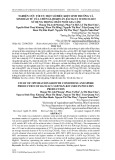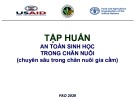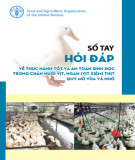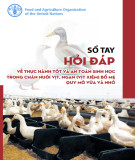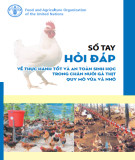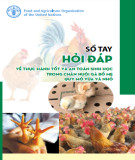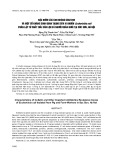
100 Nong Lam University, Ho Chi Minh City
The Journal of Agriculture and Development 23(Special issue 1) www.jad.hcmuaf.edu.vn
Efficacy of 17β-estradiol on survival rate, sex reversal, and growth performance of climbing
perch (Anabas testudineus) using the immersion method
Tuan Q. Nguyen, Tu C. P. Nguyen, Loi N. Nguyen, Minh V. Tran, Hue N. D. Truyen, & Tam T. Nguyen*
Faculty of Fisheries, Nong Lam University, Ho Chi Minh City, Vietnam
ARTICLE INFO ABSTRACT
Research Paper
Received: August 30, 2024
Revised: October 06, 2024
Accepted: October 17, 2024
Keywords
Anabas testudineus
Immersion method
17β-estradiol
Sex reversal
*Corresponding author
Nguyen Thanh Tam
Email:
nthanhtam@hcmuaf.edu.vn
This study aimed to evaluate the efficacy of estradiol on the survival
rate, sex reversal ratio, and growth performance of climbing perch
(Anabas testudineus) using the immersion method. A completely
randomized design was applied, involving three estradiol (E2)
treatment groups at concentrations of 1.0 mg/L (1E2), 1.5 mg/L
(1.5E2), and 2 mg/L (2E2), along with a control group triplications.
Seven-day-old fingerlings were exposed to the E2 solution for 2 h
before being transferred to nurseries in hapas placed in earthen
ponds at a density of 200 fish/m² for 60 days. After the hormone
treatment and 60 days of rearing, the highest survival rate was
observed in the control group (86.7%). The female ratios in the
17β-estradiol (E2) treatments ranged from 72.0% to 90.0%, which
were significantly higher than the ratio of the control group (55.6%)
(P < 0.05). The 2E2 treatment demonstrated the highest female
percentage, which was statistically greater than that observed in the
1E2 and 1.5E2 treatments (P < 0.05). The mean weight and length
of fish in the E2 treatments were greater than those in the control
treatment, although the differences were not statistically significant
(P > 0.05). Additionally, the study revealed a direct proportionality
between the average weight of experimental fish and the hormone
concentration. Based on these findings, the recommended dose for
achieving maximum mono-sex female climbing perch is 2 mg/L of
17β-estradiol.
Cited as: Nguyen, T. Q., Nguyen, T. P. C., Nguyen, L. N., Tran, M. V., Truyen, H. N. D., Nguyen,
T. T. (2024). Efficacy of 17β-estradiol on survival rate, sex reversal, and growth performance of
climbing perch (Anabas testudineus) using the immersion method. The Journal of Agriculture and
Development 23(Special issue 1), 100-107.

Nong Lam University, Ho Chi Minh City 101
The Journal of Agriculture and Development 23(Special issue 1) www.jad.hcmuaf.edu.vn
The manipulation of sex in fish populations
is essential for several reasons. In hatchery
production, achieving a desired sex ratio can
enhance reproductive efficiency and yield
(Beardmore et al., 2001). For instance, in species
where one sex grows faster or reaches market size
more quickly, producing monosex populations
can significantly improve economic returns (Mair
et al., 1997). In fish farming, controlling the sex
ratio can prevent unwanted breeding, thereby
reducing competition for resources and promoting
uniform growth (Guerrero & Guerrero, 1988).
Additionally, in conservation efforts, sex reversal
can help restore endangered populations by
ensuring a balanced sex ratio crucial for successful
breeding programs (Rubin, 1985).
Various methods have been developed to
induce sex reversal in fish, including environmental
manipulation, genetic techniques, and hormonal
treatments (Piferrer, 2001). Hormonal treatments
are the most widely used approach due to their
effectiveness and relative ease of application
(Guerrero, 1975). Common hormones include
androgens like methyltestosterone, which induce
masculinization, and estrogens such as estradiol,
which promote feminization (Yamamoto, 1969).
These hormones can be administered through
feed, injections, or immersion baths, depending
on the species and desired outcome (Pandian &
Sheela, 1995). Each method of sex reversal has its
advantages and disadvantages. Environmental
manipulation, such as temperature changes,
is non-invasive and sustainable but can be less
precise and effective (Yamamoto, 1969). Genetic
techniques offer long-term solutions and are highly
specific but involve complex and costly procedures
(Beardmore et al., 2001). Hormonal treatments are
cost-effective, easy to implement, and provide rapid
results (Pandian & Sheela, 1995).
Estradiol, a primary estrogen hormone, is
widely used to induce feminization in fish, playing
a pivotal role in sex differentiation (Guerrero,
1. Introduction
The study of sex reversal in fish has gained
significant attention due to its implications for
aquaculture and conservation. Understanding
and manipulating sex differentiation can have
profound effects on population management
and productivity (Pandian & Sheela, 1995). Sex
reversal, where an individual fish changes its sex
from male to female or vice versa, is a naturally
occurring phenomenon in several fish species
(Devlin & Nagahama, 2002). This process can be
influenced by environmental factors, social cues,
and hormonal interventions (Yamamoto, 1969).
Globally, species such as groupers, wrasses, and
clownfish are well-known for their sex-changing
capabilities (Shapiro, 1987). In Vietnam, sex
reversal is particularly relevant for species like
the Asian sea bass (Lates calcarifer) and tilapia
species (Oreochromis spp.), which are vital to
the local aquaculture industry (FAO, 2010). The
ability to control sex differentiation through
hormonal treatments has opened new avenues
for optimizing fish production and maintaining
ecological balance (Hunter & Donaldson, 1983).
Climbing perch (Anabas testudineus) is an
important food fish that is considered to be
of high quality, contributing to local people’s
livelihoods and well-being in the Mekong
Delta (Anh et al., 2003; Klemick & Lichtenberg,
2008). In growth-out farming, the use of female
climbing perch is particularly important due to
their superior growth performance compared to
males. Female climbing perch typically exhibit
faster growth rates, greater size, and improved
feed conversion efficiency, making them more
economically viable for large-scale production.
By focusing on female fish in farming operations,
farmers can optimize yield and enhance overall
productivity, contributing to more sustainable
and profitable aquaculture practices.

102 Nong Lam University, Ho Chi Minh City
The Journal of Agriculture and Development 23(Special issue 1) www.jad.hcmuaf.edu.vn
six months, from January to June 2024.
2.1. Test animals
The experimental fish used in the sex reversal
treatment were obtained from five pairs of
climbing perch broodstock (female: 13 ± 1.2
cm and 98 ± 0.6 g; male: 11 ± 1.4 cm and 79
± 0.4 g) through artificial reproduction using
hormone induction at the experimental farm of
the Faculty of Fisheries, Nong Lam University,
Ho Chi Minh City. Fertilized eggs obtained from
these broodstocks were pooled and incubated
in three separate 50-liter plastic tanks, and
maintained with gentle aeration. Post-hatching,
the larvae were kept in the same tanks, with
the water maintained at a temperature of 29 -
32°C, dissolved oxygen (DO) level at 2 - 4 mg/L,
ammonia (NH3) levels below 0.25 ppm, nitrite
levels under 1.0 ppm, and a pH range of 7.0 -
7.5. Starting at 3 - 4 days post-hatch (DPH),
the larvae were fed Moina four times daily in
adequate quantities. Upon reaching 6 days of age,
feeding was ceased for one day to facilitate the
experiment.
2.2. Preparation of hormone treated solutions
The 17β-estradiol hormone utilized in this
study was purchased from Sigma Aldrich Ltd.,
Germany. A stock solution was prepared by
dissolving 400 mg of the hormone in 1 L of 96%
ethanol, yielding a nominal concentration of 0.4
mg/mL. To achieve the treatment concentrations,
appropriate amounts of the stock solution were
dissolved in a 20 L glass flask containing 10 L of
water, followed by gently aeration to facilitate
ethanol evaporation.
2.3. Experimental design
The experiment was carried out in 20 L glass
tanks using completely randomized design.
1975). The use of estradiol in fish sex reversal
offers several advantages. It is a potent and
reliable method for achieving desired sex ratios,
particularly in species where female individuals
are preferred for their growth rates, market
value, or reproductive characteristics (Piferrer,
2001). The dosage and method of administration
vary depending on the species and desired
sex ratio (Pandian & Sheela, 1995). Typically,
estradiol is administered through feed during
the early developmental stages when gonadal
differentiation is most responsive (Hunter &
Donaldson, 1983). The feeding method for
administering hormones in fish sex reversal has
several disadvantages: (i) individual fish may
consume varying amounts of food, leading to
inconsistent hormone dosages and affecting sex
conversion results; (ii) the processing time is
lengthy, typically around 21 days; (iii) the age of
the fish must be precise, usually 1-day old after
the yolk is fully consumed; and (iv) it incurs high
production costs (Guerrero & Guerrero, 1988).
In contrast, the immersion bath method helps
overcome these disadvantages: (i) it provides
rapid and uniform hormone distribution,
ensuring consistent sex reversal results; (ii) it is
ideal for early developmental stages and hatchery
environments where large numbers of fish can
be treated simultaneously; and (iii) it has lower
production costs (Rubin, 1985). Therefore, the
research was carried out to investigate the effects
of estradiol on sex reversal, survival, and growth
of climbing perch (Anabas testudineus) using the
immersion bath method (Guerrero, 1975).
2. Materials and Methods
This experimental study was designed to
evaluate the effectiveness of producing female
monosex climbing perch by immersion method.
The experiment was conducted over a period of

Nong Lam University, Ho Chi Minh City 103
The Journal of Agriculture and Development 23(Special issue 1) www.jad.hcmuaf.edu.vn
b) Growth performance
Every 30 days, 10 fish were randomly
collected in each experimental replicate to
measure the mean growth (average weight and
length), using digital calipers and an electronic
balance, respectively, then released the fish back
into experimental hapas. Survival rates were
recorded at two hours after immersion of fish
in E2 solutions and at the end of the growth
experiment (day 60).
c) Statistical analysis
The data were statistically analyzed by
statistical package SPSS version 16.0 in which
data were subjected to one-way ANOVA and
Duncan’s multiple range test (DMRT) was used
to determine the significant differences between
the means at 5% level of significance.
3. Results
The water quality parameters maintained during
the experiment are summarized in Table 1. The
temperature ranged from 29 to 32°C, DO levels
varied between 2.0 and 4.0 mg/L, pH levels ranged
from 7.0 to 7.5, and NH3 levels were kept below 0.25
mg/L. These parameters were within the optimal
range for the growth and survival of climbing perch
(Anabas testudineus), ensuring a stable environment
throughout the study (Boyd, 1998).
The experiment involved three 17β-estradiol
(E2) concentration treatments: 1 mg/L (1E2),
1.5 mg/L (1.5E2), and 2 mg/L (2E2), along
with a control treatment (C). Each treatment
was replicated three times. 7-day-old fry were
randomly selected from three nursery tanks and
placed into experimental glass tanks at a density
of 500 fish/L for 2 h. Post hormone treatment,
the fry were transferred to separate nursery
hapas (1 m x 1 m x 0.5 m) at a density of 200 fish/
m² for a duration of 60 days. During this period,
the fish were fed commercial floating pellets with
varying crude protein levels: 40% from days 1
to 15, at a feeding rate of 10% of body weight,
administered four times daily; 35% from days
16 to 30, at a feeding rate of 7% of body weight,
administered three times daily; and 30% from
days 31 to 60, at a feeding rate of 5% of body
weight, administered twice daily.
2.4. Sampling and data collection
a) Sex reversal
At the end of experiment, 30 fish were
randomly collected in each experimental
replicate to identify the sex of the fishes (total 90
fish/treatment). Morphology of the gonads were
examined and recorded. Sexing determination
was done by standard aceto-carmine gonad
squashing technique (Guerrero & Shelton, 1974).
Table 1. Water quality parameters during experiment
Temperature (°C) Dissolved oxygen (mg/L) pH NH3 (mg/L)
29.0 - 32.0 2.0 - 4.0 7.0 - 7.5 < 0.25
The survival rates and mean percent females
for each estradiol-17β treatment group and
the control group are shown in Table 2. All
groups exhibited a 100% survival rate after 2 h
of treatment, indicating that the initial exposure
to 17β-Estradiol did not negatively impact the
immediate survival of the fish. However, the
survival rate at day 60 showed slight variations
among these groups. The control group had
a survival rate of 86.7%, whereas the treated
groups showed lower survival rates: 82% for
1E2, 81.3% for 1.5E2, and 80.7% for 2E2.

104 Nong Lam University, Ho Chi Minh City
The Journal of Agriculture and Development 23(Special issue 1) www.jad.hcmuaf.edu.vn
experimental results demonstrated that the
highest feminization rate of 90% occurred in
the 2E2 treatment (2 mg/L E2 concentration),
a statistically significant difference compared to
other E2 treatments (P > 0.05). This indicates that
a concentration of 2 mg/L E2 is an effective dose
for feminizing climbing perch via immersion.
Consequently, the 2E2 treatment (2 mg/L E2)
is identified as the most suitable concentration
for sex reversal in climbing perch fry using the
immersion method.
Histological analysis of gonadal tissues
revealed no intersex individuals across all
estradiol treatments and control groups (Table
2; Figure 1). The effectiveness of 17β-Estradiol
in sex reversal was evident in the increase
in the percentage of females in the treated
groups compared to the control. The control
group exhibited a normal sex ratio of 1 female
to 0.80 male. In contrast, the female ratios in
the E2 treatments varied from 72% to 90%,
which were significantly higher than the 55.6%
observed in the control group (P < 0.05). The
Table 2. Effects of 17β-Estradiol on survival, sex reversal, and growth in climbing perch (Anabas
testudineus)
Treatment Number of
analyzed fish
Survival
rate after
2 h (%)
Survival rate at
day 60 (%) Female (%) Male (%) Sex ratio
Female:Male
Control 90 100 86.67 ± 1.15 55.56 ± 5.09a44.4 01:00.8
1E2 90 100 82.00 ± 2.00 72.00 ± 4.00b28.0 01:00.4
1.5E2 90 100 81.33 ± 3.06 72.92 ± 3.61b27.1 01:00.4
2E2 90 100 80.67 ± 3.06 90.0 ± 3.33c10.0 01:00.1
Values (mean ± standard deviation of data for triplicate groups) with different superscripts in the same column
are significantly different (one-way ANOVA and Tukey test, P < 0.05).
Figure 1. The observed gonad of male and female climbing perch after 60 days of 17β-Estradiol
treatment. (A) Gonad removal (B) Eggs, and (C) Testis under light microscope.
A B C
The growth performance of the experimental
fish over 60 days is detailed in Table 3. The
control group showed a final weight of 8.112 ±
0.203 g and a specific growth rate (SGR) of 14.564
± 0.042 %/day. The group treated with 2 mg/L
estradiol-17β had the highest final weight (8.494
± 0.214 g) and SGR (14.641 ± 0.042 %/day),
indicating that higher doses of estradiol-17β
may positively influence growth performance
(Pandian & Sheela, 1995).



